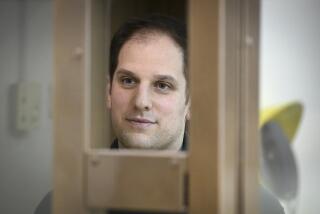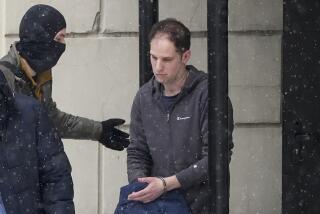Journalist freed after behind-the-scenes negotiations
The first phone call jolted the modest Redondo Beach town house in the middle of the night. Many others like it would follow, for nearly three years. The voices on the other end of the line would vary, but all were insistent — turn over millions of dollars or you will never see your son again.
It was a mother’s burden to field the calls and do anything she could to try to save her son, kidnapped journalist Michael Scott Moore. Marlis Saunders answered the phone time after time, and made calls of her own to the Somali pirates who were holding her son in one of the world’s most lawless areas.
The faceless captors showed no sign of backing down until two months ago, when something changed. They suddenly gave up their most outrageous ransom demand and began to bargain. Saunders said she finally felt reason for hope.
When her son’s freedom finally came this week, his colleagues said it was owed to a mother’s resilience and resolve — along with the delivery of a smaller, unspecified payoff.
Freed on Tuesday after 32 months of captivity, Moore flew to Kenya and planned to travel to Berlin this weekend. The young man who learned to surf in the South Bay and turned that passion into novels about surfing and foreign cultures planned to be reunited with his mother. It was a ray of good news after the recent beheadings in Syria of two American journalists by Muslim extremists.
“I am just overjoyed,” Saunders said Thursday in her first interview about the long ordeal. “I am ecstatic.”
She said her son, who has joint German and American citizenship, told her that he would spend some time in Berlin before returning to the South Bay, where he attended Mira Costa High School and began writing for the school newspaper.
“I’m not healthy but I am safe,” Moore, 45, said in a statement. “It’s an astonishing story, but right now I have to recover my wits and spend time with family and friends.” Moore asked journalists to give him some space for now, and his mother said she preferred to do the same.
The journalist’s odyssey began Jan. 21, 2012, in the town of Galkayo, where he was nearing the end of a month of research on the pirates who do much of their work in the waters around the Horn of Africa.
Moore had been to Somalia before and was traveling this time with a $12,000 grant from the Pulitzer Center on Crisis Reporting, which finances journalism on underreported issues. He planned magazine articles and a book because he felt people in the West did not know enough about the troubled country and the conditions driving the kidnappers.
The veteran journalist had a team of locals guiding and protecting him, but his colleagues later reported that his security team betrayed him for a cash payment.
Two days after he disappeared, Saunders said, the phone calls began. The kidnappers put her son on the phone.
“He said, ‘They need this money right away for me to get free,’ ” Saunders said. “He said, ‘I need to get out of here.’ ”
The pirates allowed Moore on the line again about a week later. Periodically, over the long months, he spoke to his mother, though only for moments at a time. She always felt like someone was standing over him, and the talks seemed to end abruptly.
“I could never talk freely or ask him many questions, and the connection was so bad it was almost useless to try to have a conversation,” Saunders said.
Saunders said she got directives from the U.S. government and from other advisors, but she declined to give details. Although some of Moore’s captors spoke English, his mother preferred to have a translator with her, or on a conference line, to “prevent any confusion or mistakes.”
The mother, other relatives, friends and colleagues made a decision early on that they would say little publicly about the abduction. They believed that if the case drew more attention, the pirates would be convinced that they held a valuable prize.
“They were thinking all Americans were terribly rich and they expected a lot,” Saunders said.
Just four days after the abduction, U.S. Navy SEALs rescued an American relief worker and her Danish co-worker in a nighttime raid while killing all nine of their guards. At the time, a pirate from the area where the rescue took place told The Times that pirates would be much more careful to keep U.S. hostages better secured.
Saunders said the pirates with whom she spoke thought they would receive restitution from the U.S. government for those killings. She told them they would not. She also told them the government would not pay any money for her son.
They proposed other solutions. Why not a fundraiser in which American donors each gave $1? They also suggested Saunders ask her church for money. “For the longest time they were not coming down in the demand,” she said. “And then, all of a sudden, they were able to come down, together with us.”
Saunders said she had no idea what led to the change. A rebel commander claimed that his group had received $1.6 million to free Moore, but his mother said that figure was high. She would only say that she raised the money with the help of family and friends.
Moore received some acclaim for “Sweetness and Blood,” his 2010 book on how surfing spread around the globe. It was more of a cultural kaleidoscope than a standard odyssey in search of the perfect wave. The New York Times called it “a fresh, unexpected cartography of the waves.”
Saunders appreciated those adventures but she also laughed when asked if she had tried before to get her son to settle into more conventional work. Would he change now?
“I think that is a question mark,” she said. “But maybe he will think about it now.”
More to Read
Start your day right
Sign up for Essential California for news, features and recommendations from the L.A. Times and beyond in your inbox six days a week.
You may occasionally receive promotional content from the Los Angeles Times.








